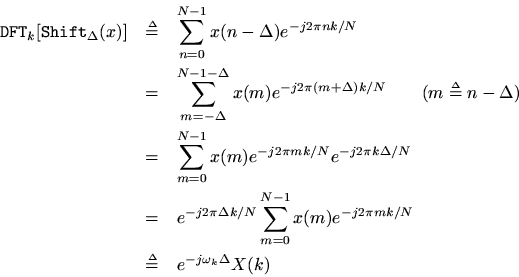NOTE: THIS DOCUMENT IS OBSOLETE, PLEASE CHECK THE NEW VERSION: "Mathematics of the Discrete Fourier Transform (DFT), with Audio Applications --- Second Edition", by Julius O. Smith III, W3K Publishing, 2007, ISBN 978-0-9745607-4-8. - Copyright © 2017-09-28 by Julius O. Smith III - Center for Computer Research in Music and Acoustics (CCRMA), Stanford University
<< Previous page TOC INDEX Next page >>
Shift Theorem
Theorem: For anyand any integer
,
Proof:
The shift theorem says that a delay in the time domain corresponds to a linear phase term in the frequency domain. More specifically, a delay ofsamples in the time waveform corresponds to the linear phase term
multiplying the spectrum, where
. (To consider
as radians per second instead of radians per sample, just replace
by
so that the delay is in seconds instead of samples.) Note that spectral magnitude is unaffected by a linear phase term. That is,
.
Subsections
